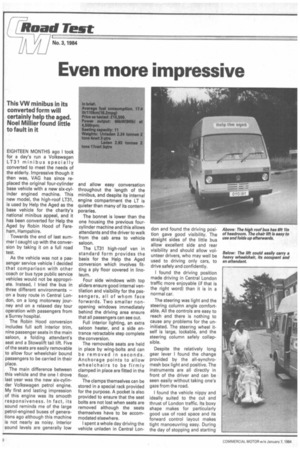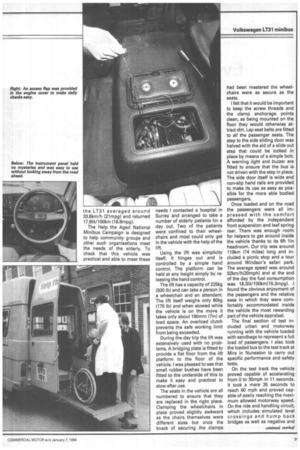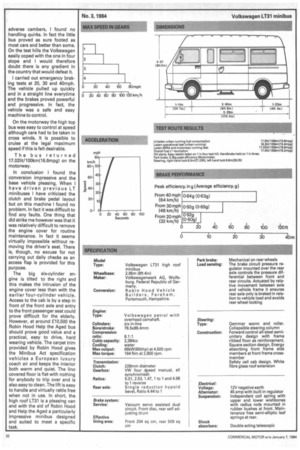Even more impressive
Page 34

Page 35

Page 36

If you've noticed an error in this article please click here to report it so we can fix it.
This VW minibus in its converted form will certainly help the aged. Noel Millier found little to fault in it
EIGHTEEN MONTHS ago I took for a day's run a Volkswagen LT31 minibus specially converted to meet the needs of the elderly. Impressive though it then was, VAG has since replaced the original four-cylinder base vehicle with a new six-cylinder engined machine. This new model, the high-roof LT31, is used by Help the Aged as the base vehicle for the charity's national minibus appeal, and it has been converted for Help the Aged by Robin Hood of Fareham, Hampshire.
Towards the end of last summer I caught up with the conversion by taking it on a full road test.
As the vehicle was not a passenger service vehicle I decided that comparison with other coach or bus type public service vehicles would not be appropriate. Instead, I tried the bus in three different environments — on a busy route in Central London, on a long motorway journey and on a relaxed day tour operation with passengers from a Surrey hospital.
The Robin Hood conversion includes full soft interior trim, nine passenger seats in the main saloon, a folding attendant's seat and a Stowalift tail lift. Five of the seats are easily removable to allow four wheelchair bound passengers to be carried in their place.
The main difference between this vehicle and the one I drove last year was the new six-cylinder Volkswagen petrol engine. My first and lasting impression of this engine was its smooth responsiveness. In fact, its sound reminds me of the large petrol-engined buses of generations ago although this machine is not nearly as noisy. Interior sound levels are generally low and allow easy conversation throughout the length of the minibus, and despite its internal engine compartment the LT is quieter than many of its contemporaries.
The bonnet is lower than the one housing the previous fourcylinder machine and this allows attendants and the driver to walk from the cab area to vehicle saloon.
The LT31 high-roof van in standard form provides the basis for the Help the Aged conversion which involves fitting a ply floor covered in linoleum.
Four side windows with top sliders ensure good internal ventilation and visibility for the passe n g e rs, all of whom face forwards. Two smaller nonopening windows immediately behind the driving area ensure that all passengers can see out.
Full interior lighting, an extra saloon heater, and a side entrance retractable step complete the conversion.
The removable seats are held in place by wing-bolts and can be removed in seconds. Anchorage points to allow wheelchairs to be firmly clamped in place are fitted in the floor.
The clamps themselves can be stored in a special rack provided for the purpose. A pocket is also provided to ensure that the seat bolts are not lost when seats are removed although the seats themselves have to be accommodated elsewhere.
I spent a whole day driving the vehicle unladen in Central Lon
don and found the driving position gave good visibility. The straight sides of the little bus allow excellent side and rear visibility and should allow volunteer drivers, who may well be used to driving only cars, to drive safely and confidently.
I found the driving position made driving in Central London traffic more enjoyable (if that is the right word) than it is in a normal car.
The steering was light and the steering column angle comfortable. All the controls are easy to reach and there is nothing to cause any problems for the uninitiated. The steering wheel itself is large, lockable, and the steering column safely collapsible.
Despite the relatively long gear lever I found the change provided by the all-synchromesh box light and positive. The instruments are all directly in front of the driver and can be seen easily without taking one's gaze from the road.
I found the vehicle nippy and ideally suited to the cut and thrust of London traffic. Its boxy shape makes for particularly good use of road space and its forward control layout makes tight manoeuvring easy. During the day of stopping and starting the LT31 averaged around 33.8km/h (21mpg) and returned 17.91it/100km (18.8mpg).
The Help the Aged National Minibus Campaign is designed to help community groups and other such organisations meet the needs of the elderly. To check that this vehicle was practical and able to meet these needs I contacted a hospital in Surrey and arranged to take a number of elderly patients for a day out. Two of the patients were confined to their wheelchairs and most could only get in the vehicle with the help of the lift.
Using the lift was simplicity itself. It hinges out and is controlled by a simple hand control. The platform can be held at any height simply by releasing the hand control.
The lift has a capacity of 225kg (500 lb) and can take a person in a wheelchair and an attendant. The lift itself weighs only 80kg (175 lb) and when stowed while the vehicle is on the move it takes only about 190mm (71n) of load space. An overload clutch prevents the safe working limit from being exceeded.
During the day trip the lift was extensively used with no problems. A bridging plate is fitted to provide a flat floor from the lift platform to the floor of the vehicle. I was pleased to see that small rubber bushes have been fitted to the underside of this to make it easy and practical to stow after use.
The seats in the vehicle are all numbered to ensure that they are replaced in the right place. Clamping the wheelchairs in place proved slightly awkward as the chairs themselves were different sizes but once the knack of securing the clamps had been mastered the wheelchairs were as secure as the seats.
I felt that it would be important to keep the screw threads and the clamp anchorage points clean, as being mounted on the floor they would otherwise attract dirt. Lap seat belts are fitted to all the passenger seats. The step to the side sliding door was halved with the aid of a slide out step that could be locked in place by means of a simple bolt. A warning light and buzzer are fitted to ensure that the bus is not driven with the step in place. The side door itself is wide and non-slip hand rails are provided to make its use as easy as possible for the more able bodied passengers.
Once loaded and on the road the passengers were all impressed with the comfort afforded by the independent front suspension and leaf spring rear. There was enough room for helpers to get around inside the vehicle thanks to its 6ft 1in headroom. Our trip was around 119km (74 miles) long and included a picnic stop and a tour around Windsor's safari park. The average speed was around 52km/h(30mph) and at the end of the day the fuel consumption was 18.31it/100km(15.3mpg). I found the obvious enjoyment of the passengers and the relative ease in which they were comfortably accommodated inside the vehicle the most rewarding part of the vehicle appraisal.
The final section of test included urban and motorway running with the vehicle loaded with sandbags to represent a full load of passengers. I also took the loaded bus to the test track at Mira in Nuneaton to carry out specific performance and safety tests.
On the test track the vehicle proved capable of accelerating from 0 to 30mph in 11 seconds. It took a mere 35 seconds to reach 60 mph and proved capable of easily reaching the maximum allowed motorway speed. On the ride and handling circuit, which includes simulated level crossings and hump back bridges as well as negative and adverse cambers, I found no handling quirks. In fact the little bus proved as sure footed as most cars and better than some. On the test hills the Volkswagen easily coped with the one in four slope and I would therefore doubt there is any gradient in the country that would defeat it.
carried out emergency braking tests at 20, 30 and 40mph. The vehicle pulled up quickly and in a straight line everytime and the brakes proved powerful and progressive. In fact, the vehicle was a safe and easy machine to control.
On the motorway the high top bus was easy to control at speed although care had to be taken in cross winds. It is possible to cruise at the legal maximum speed if this is felt desirable.
The bus returned 17.0211t/100km(16.6mpg) on the motorway.
In conclusion I found the conversion impressive and the base vehicle pleasing. When I have driven previous LT minibuses I have criticised the clutch and brake pedal layout but on this machine I found no problem. In fact it was difficult to find any faults. One thing that did strike me however was that it was relatively difficult to remove the engine cover for routine maintenance. In fact it seems virtually impossible without removing the driver's seat, There is, though, no excuse for not carrying out daily checks as an access flap is provided for this purpose.
The big six-cylinder engine is tilted to the right and this makes the intrusion of the engine cover less than with the earlier four-cylinder vehicle. Access to the cab is by a step in front of the front axle and entry to the front passenger seat could prove difficult for the elderly. However, at around £10,500 the Robin Hood Help the Aged bus should prove good value and a practical, easy to drive, hard wearing vehicle. The carpet trim provided by Robin Hood gives the Minibus Act specification vehicles a European luxury coach air and keeps the interior both warm and quiet. The lino covered floor is flat with nothing for anybody to trip over and is also easy to clean. The lift is easy to handle and virtually rattle free when not in use. In short, the high roof LT31 is a pleasing van and with the aid of Robin Hood and Help the Aged a particularly impressive minibus designed and suited to meet a specific task.










































































